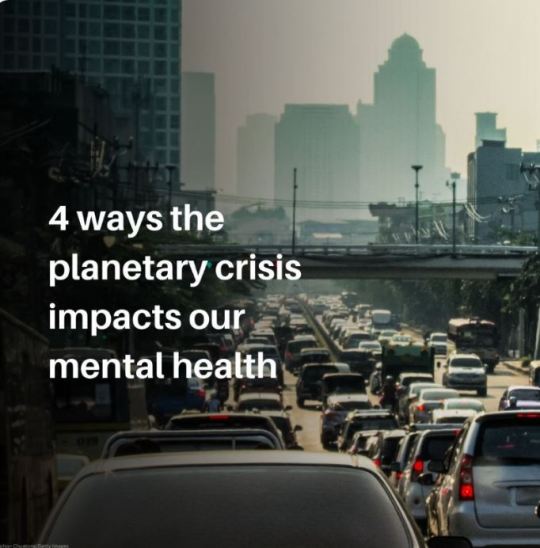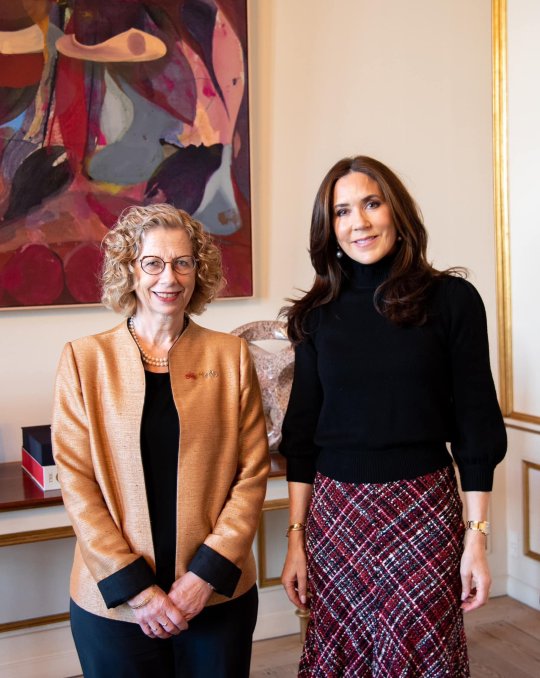#UN Environment Programme (UNEP)
Text
4 Ways the planetary crisis impacts our mental health.

Climate change, noise, and air and chemical pollution impact our mental well-being. However, a healthy environment can uplift us. This #WorldMentalHealthDay, explore these four environmental issues and how nature and #ClimateAction offer solutions.
#Climate change#noise#chemical pollution#unep#Air pollution#un environment programme#mental illnesses#mental health#climate action
0 notes
Text
Highlight the Impacts of Sand and Dust Storms on Oceans.

Each year, an estimated two billion tonnes of dust is raised into the atmosphere. According to the report, Impacts of Sand and Dust Storms on Oceans: A Scientific Environmental Assessment for Policy Makers, even the smallest elements can have substantive effects on ecosystem functioning – and on the Earth system, at large.
Facts & Figures
Approximately 2 million tonnes of sand and dust enter the atmosphere annually.
SDS mostly occur in dry and desert regions, but can be carried long distances to impact regions much further away.
Dust particles, circulated by SDS, provide nutrients to marine ecosystems, but can also contribute to coral mortality and hurricane formation.
SDS can cause respiratory diseases, heart disorders, and eye and skin irritation and can also spread other diseases, such as meningitis.
Aviation and ground transportation can be disrupted by SDS.
Agricultural practices and productivity can be impacted by SDS, which can also contribute to desertification processes.
Sustainable water and land management practices can decrease the impacts of SDS.
Source: UN Environment Management Group
#dust storms#severe sand#Sand and Dust Storms#fine dust particles#effects on ecosystem#ocean basin#un environment programme#unep#International Day of Combatting Sand and Dust Storms#12 july
0 notes
Text
Women, Natural Resources and Peacebuilding.

The report Women and Natural Resources: Unlocking the Peacebuilding Potential PDFurges governments and the international community to invest in the political and economic engagement of women in natural resource management and to end the entrenched discrimination that women face in accessing, owning and using critical natural resources in sustainable and productive ways.
Published jointly by the United Nations Environment Programme (UNEP), the United Nations Entity for Gender Equity and the Empowerment of Women (UN Women), the United Nations Development Programme (UNDP) and the United Nations Peacebuilding Support Office (PBSO), this report draws on field research from over 20 different countries and some 200 academic sources and institutions.
Women and Natural Resources: Unlocking the Peacebuilding Potential.
#United Nations Environment Programme (UNEP)#United Nations Entity for Gender Equity and the Empowerment of Women#UN-Women#natural resources#women in diplomacy#women in peacebuiding#inclusive peacebuilding#Peacebuilding Support Office (PBSO)#United Nations Development Programme (UNDP)#academic institutions
0 notes
Text
United Nations Environment Programme’s Instagram needs to do better.
Maybe you've come across the UNEP before, but to quote them, they are "the leading global authority on the environment" and their "mission is to inspire, inform, and enable nations and peoples to improve their quality of life without compromising that of future generations" [1], and indeed their Instagram page compliments this to an extent.

They do share inspirational stories and inform with recent data. However, they completely lack brand identity, leading to their posts feeling inconsistent. There is no instantaneous recognizable detail to their individual posts that immediately informs you that this is the UNEP, a reliable source for environmental information. In an era of doom scrolling and fake news, shouldn't the UNEP do what little effort they can to ensure their over two million followers are at least registering their posts to be from them?
In the below screenshot of their most recent posts (as of 9 June 2023), how many different fonts do they use across posts? How is it that World Seaweed Day and World Food Safety Day look wildly different as if created by different accounts? It is likely that the team working on marine information differs from the food safety team, however that is where brand identity must unite. The topics at hand are already a vast range, should there not be a consistency to pull it together?

I'd love to see this Instagram page improve it's brand identity given that the UNEP does incredibly important work which may be going unrecognized and under-appreciated as such. Strengthening the instant recognition that a post is from the UNEP would greatly benefit them in that their audience may actually pause to read their posts if they know the source is such a reliable and globally unified one.
Finally, I'd like to acknowledge that their website has a beautiful brand identity within the UN aesthetic, so my belief is not that they have no awareness of brand identity, they simply have not found a way to pull from that insight and extrapolate it towards their instagram page.

Ideally, this is the sort of project I would like to work on in the future as a (science) communicator. In essence curating content and creating an identifiable brand in everything from font to writing style such that important messages may be received well by the audience. It is a shame to be overlooked over something as adjustable as aesthetics.
#UN#United Nations#UNEP#United Nations Environment Programme#Brand identity#branding#identity#Environment#Environmental stories#Education#Environmental education#Social media#Instagram#Meta#Eurydike's#Eurydike on media#IG
0 notes
Text
Global Mangrove Watch.

The Global Mangrove Watch (GMW) was initiated as part of the JAXA Kyoto & Carbon Initiative in 2011. It is led by Aberystwyth University and solo Earth Observation, in collaboration with Wetlands International, the International Water Management Institute and the United Nations Environment World Conservation Monitoring Centre (U.K.). The African part is supported by DOB Ecology through the Mangrove Capital Africa project. The GMW aims to provide geospatial information about mangrove extent and changes to the Ramsar Convention, national wetland practitioners, decision makers and NGOs. It is part of the Ramsar Science and Technical Review Panel (STRP) work plan for 2016-2018 and a Pilot Project to the Ramsar Global Wetlands Observation System (GWOS), which is implemented under the GEO-Wetlands Initiative. The primary objective of the GMW has been to provide countries lacking a national mangrove monitoring system with first cut mangrove extent and change maps, to help safeguard against further mangrove forest loss and degradation.The GMW has generated a global baseline map of mangroves for 2010 using ALOS PALSAR and Landsat (optical) data, and changes from this baseline for epochs between 1996 and 2020 derived from JERS-1 SAR, ALOS PALSAR and ALOS-2 PALSAR-2. Annual maps are planned from 2018 and onwards.
The GMW has generated a global baseline map of mangroves for 2010 using ALOS PALSAR and Landsat (optical) data, and changes from this baseline for epochs between 1996 and 2020 derived from JERS-1 SAR, ALOS PALSAR and ALOS-2 PALSAR-2. Annual maps are planned from 2015 and onwards.
#Global Mangrove Watch (GMW)#Mangrove#vegetation#safeguard mangroves#GEO-Wetlands Initiative#Ramsar Global Wetlands Observation System (GWOS)#National mangrove monitoring system#International Water Management Institute#unep wcmc#un environment programme#Mangrove Capital Africa project#United Nations Environment World Conservation Monitoring Centre#JAXA Kyoto#Carbon initiative
0 notes
Text
Focus on Conflicts involving natural resources.
The United Nations Environment Programme (UNEP) has found that over the last 60 years, at least 40 percent of all internal conflicts have been linked to the exploitation of natural resources, whether high-value resources such as timber, diamonds, gold and oil, or scarce resources such as fertile land and water. Conflicts involving natural resources have also been found to be twice as likely to relapse.
0 notes
Text
Develop and implement policies; policies which support low-carbon, resource efficient and green growth as well as policies on mitigation and adaptation to climate change.
In an increasingly urbanized world, UN Environment Programme (UNEP) and our partners support cities across the world in addressing environmental impacts and integrating the environment into cities’ long-term strategic planning. We focus on buildings and infrastructure, transport, air pollution, waste and water management, biodiversity and ecosystems.
#low-carbon#Green growth#climate adaptation#climate mitigation#cities#towns#UN Environment Programme (UNEP)
0 notes
Text
"The Air We Share".
The Chief Scientists of the World Health Organization (WHO), the International Union for Conservation of Nature (IUCN), the World Meteorological Organization (WMO) and the UN Environment Programme (UNEP) have come together to highlight the theme of the 2022 International Day of Clean Air for blue skies, "The Air We Share," stressing collaboration and connection.
#International Union for Conservation of Nature (IUCN)#World Health Organization (WHO)#World Meteorological Organization (WMO)#UN Environment Programme (UNEP)#Statements#International Day of Clean Air for Blue Skies#7 September
0 notes
Text
The FAO roadmap was published at the Cop28 climate summit in December and accepts that diets “absolutely must [change] for human and planetary health”. But its 120 actions do not include reducing meat and dairy consumption in nations where most people already eat unhealthy amounts. Instead, many of the FAO’s recommendations are to intensify the efficiency of animal farming techniques.
“It’s very striking: the FAO doesn’t include one of the clearest interventions that would help meet both environmental and health targets,” said Cleo Verkuijl, of the Stockholm Environment Institute US and one of the eight authors of the commentary from academic institutions in the US, the Netherlands and Brazil.
“Also really surprising is the fact that the FAO completely dismisses alternative proteins,” she said. These had been shown to have far smaller environmental impacts than conventional meat but the FAO claimed, without providing evidence, that plant-based meats had “nutritional deficiencies”, the experts said.
A report from the UN Environment Programme (Unep), published in December, said “alternatives to animal products such as meat and dairy may contribute to significantly reducing the environmental footprint of the current global food system”.
58 notes
·
View notes
Text
Countries' greenhouse gas-cutting pledges put Earth on track for warming far beyond key limits, potentially up to a catastrophic 2.9 degrees Celsius this century, the UN said Monday, warning "we are out of road".
The UN Environment Programme's annual Emissions Gap report is released just ahead of crucial COP28 climate talks in Dubai and will feed into the global response to a sobering official "stocktake" of the failure to curb warming so far.
With this year expected to be the hottest in human history, UNEP said "the world is witnessing a disturbing acceleration in the number, speed and scale of broken climate records".
Taking into account countries' carbon-cutting plans, UNEP warned that the planet is on a path for disastrous heating of between 2.5C and 2.9C by 2100. Based just on existing policies and emissions-cutting efforts, global warming would reach 3C.
Continue Reading.
86 notes
·
View notes
Text
If one of your initiatives is helping to solve the triple global crisis of climate change, pollution and biodiversity loss, then the Champions of the Earth award could be for you.
The call for entries launched by the United Nations Environment Programme (UNEP) is open until 5 May 2024.
21 notes
·
View notes
Text

Queen Mary today met with Inger Andersen, Executive Director of the United Nations Environment Programme (UNEP), and heard about the organization's work on promoting biodiversity and nature conservation, and was briefed about the recent UN Environment Assembly in Nairobi, Kenya.
23 notes
·
View notes
Text
There is “no credible pathway to 1.5C in place”, the UN’s environment agency has said, and the failure to reduce carbon emissions means the only way to limit the worst impacts of the climate crisis is a “rapid transformation of societies”.
The UN environment report analysed the gap between the CO2 cuts pledged by countries and the cuts needed to limit any rise in global temperature to 1.5C, the internationally agreed target. Progress has been “woefully inadequate” it concluded.
Current pledges for action by 2030, if delivered in full, would mean a rise in global heating of about 2.5C and catastrophic extreme weather around the world. A rise of 1C to date has caused climate disasters in locations from Pakistan to Puerto Rico.
If the long-term pledges by countries to hit net zero emissions by 2050 were delivered, global temperature would rise by 1.8C. But the glacial pace of action means meeting even this temperature limit was not credible, the UN report said.
Countries agreed at the Cop26 climate summit a year ago to increase their pledges. But with Cop27 looming, only a couple of dozen have done so and the new pledges would shave just 1% off emissions in 2030. Global emissions must fall by almost 50% by that date to keep the 1.5C target alive.
Inger Andersen, the executive director of the UN Environment Programme (UNEP), said: “This report tells us in cold scientific terms what nature has been telling us all year through deadly floods, storms and raging fires: we have to stop filling our atmosphere with greenhouse gases, and stop doing it fast.
“We had our chance to make incremental changes, but that time is over. Only a root-and-branch transformation of our economies and societies can save us from accelerating climate disaster.
“It is a tall, and some would say impossible, order to reform the global economy and almost halve greenhouse gas emissions by 2030, but we must try,” she said. “Every fraction of a degree matters: to vulnerable communities, to ecosystems, and to every one of us.”
Andersen said action would also bring cleaner air, green jobs and access to electricity for millions.
The UN secretary general, António Guterres, said: “Emissions remain at dangerous and record highs and are still rising. We must close the emissions gap before climate catastrophe closes in on us all.”
Prof David King, a former UK chief scientific adviser, said: “The report is a dire warning to all countries – none of whom are doing anywhere near enough to manage the climate emergency.”
The report found that existing carbon-cutting policies would cause 2.8C of warming, while pledged policies cut this to 2.6C. Further pledges, dependent on funding flowing from richer to poorer countries, cut this again to 2.4C.
New reports from the International Energy Agency and the UN’s climate body reached similarly stark conclusions, with the latter finding that the national pledges barely cut projected emissions in 2030 at all, compared with 2019 levels.
The UNEP report said the required societal transformation could be achieved through government action, including on regulation and taxes, redirecting the international financial system, and changes to consumer behaviour.
It said the transition to green electricity, transport and buildings was under way, but needed to move faster. All sectors had to avoid locking in new fossil fuel infrastructure, contrary to plans in many countries, including the UK, to develop new oil and gas fields. A study published this week found “large consensus” across all published research that new oil and gas fields are “incompatible” with the 1.5C target.
The UNEP report said about a third of climate-heating emissions came from the global food system and these were set to double by 2050. But the sector could be transformed if governments changed farm subsidies – which are overwhelmingly harmful to the environment – and food taxes, cut food waste and helped develop new low-carbon foods.
Individual citizens could adopt greener, healthier diets as well, the report said.
Andersen said: “I’m not preaching one diet over another, but we need to be mindful that if we all want steak every night for dinner, it won’t compute.”
Redirecting global financial flows to green investments was vital, the report said. Most financial groups had shown limited action to date, despite their stated intentions, due to short-term interests, it said. A transformation to a low-emissions economy was expected to need at least $4tn-6tn a year in investment, the report said, about 2% of global financial assets.
Despite Andersen’s doubts that the necessary emission cuts can be made by 2030, she pointed to the plummeting costs of renewables, the rollout of electric transport, major climate legislation in the US, and moves by pension funds to back low-carbon investments.
“It’s my job to be the ever hopeful person, but [also] to be the realistic optimist,” she said. “[This report] is the mirror that we’re holding up to the world. Obviously, I want to be proven wrong and see countries taking ambitious steps. But so far, that’s not what we’ve seen.”
#incredible how they still have to dance around things people may not want to hear for fear it will shut things down entirely#climate change#1.5c#science news
54 notes
·
View notes
Text
HELLO welcome to WAWF WEDNESDAY your monthly WAWF update [1st Wednesday of each month]
*Considering it is now April [aka Earth Month/the month of Earth Day] WAWF brings to you an Earth inspired cover from the NOAA’s new imaging satellite along with some positive Earth facts and much more*
Read below to find out what else WAWF is up to this month
WAWF NEWS: Earth Facts & Updates

1. The theme for both Earth Day and Earth Month 2023 is “Invest In Our Planet”
2. Fungi naturally digest minerals from rocks as well as clean up fossil fuel spills. This also causes them to assist in de-radiating the environment {learn more at 8billiontrees.com}
3. The UNEP [UN Enviorment Programme] recently reports that the Earth’s ozone layer is currently on track to recover within four decades. {learn more at euronews.com}
4. Humans today consume the same water Dinosaurs did. The amount of water on Earth is always the same and is being recycled by weather patterns. {learn more at 8billiontrees.com}
5. Richard Harriman has come up with the idea of a water cleaning robot [inspired by the whale shark’s wide mouth] that collects 21,000 plastic bottles in a day. {learn more at euronews.com}
[CLICK ALT FOR PIC DETAIL]
WHAT WE’RE CRANKING:

-Recent: CALL ME IF YOU GET LOST: The Estate Sale [Album Deluxe] - Tyler, The Creator
Honorable Mentions: Starboy [Deluxe Video Album] - The Weeknd, Did you know that there’s a tunnel under Ocean Blvd [Album] - Lana Del Rey, Keed Talk To ‘Em 2 [Album] - Lil Keed, Gumbo [Album] - Young Nudy, Afterlyfe [Album] - Yeat, Don’t Get Too Close [Album] - Skrillex, UGLY [Album] - Slowthai, The Great Escape [Album] - Larry June, Red Moon In Venus [Album] - Kali Uchis, PORTALS [Albums] - Melanie Martinez, Familiarity [Song] - Teezo Touchdown

-Lowkey: Mafia Musik [Album] - D. Savage
Honorable Mentions: Reverence [Album] - Iayze, Stuck In My Ways [Album] - Summrs, Golden Child, Chapter 3 [Album] - Autumn!, Blow Up [Album] - Bear1Boss, My Vision [Album] - Luh Tyler, Gomd [Song] - Veeze, Wake Up [Song] - Dom Corleo, heyy/goodbye [Song] - 1xsimon

-Still in rotation: SICK! [Album] Earl Sweatshirt
Honorable Mentions: Ramona Park Broke My Heart [Album] - Vince Staples, Spiderr [Album] - Bladee, D.M.B [Song] - Asap Rocky, Escapism [Song] - RAYE & 070 Shake, Spin Bout U [Song] - Drake & 21 Savage, Low Down [Song] - Lil Baby, Fresh Prince Of Utah - [Song] NBA Youngboy, Walk [Song] - Kodak Black

-Throwback: The Massacre [Album] - 50 Cent
Honorable Mentions: Tha Carter III [Album] - Lil Wayne, The College Dropout [Album] - Kanye West, The Eminem Show [Album] - Eminem, Let Go [Album] - Avril Lavigne
WAWF’s Wearing


[Fit 1] - @rachelm.tnguyen [on IG] for GLM Club by @vyngak



[Fit 2-4] - @alliedruryy @aarii.xo @caitlynkrokos [on IG] in @hugh.byfitzgodwin [on IG] for GGG Shoot by @vyngak
*send your best fit pic to @whataweirdfeeling on Instagram for your own possible feature in the 'WAWF’s Wearing' section next month*
WAWF Magazine pushes art fashion culture and much more Stay tuned for all of the exciting things we have planned for 2023
Words/Curated by @vyngak
3 notes
·
View notes
Text
Comprehensive global database of marine and terrestrial protected areas.

The World Database of Protected Areas (WDPA) is the most comprehensive global database of marine and terrestrial protected areas, updated on a monthly basis, and is one of the key global biodiversity data sets being widely used by scientists, businesses, governments, International secretariats and others to inform planning, policy decisions and management. The WDPA is a joint project between United Nations Environment Programme and the International Union for Conservation of Nature (IUCN). The compilation and management of the WDPA is carried out by United Nations Environment Programme World Conservation Monitoring Centre (UNEP-WCMC), in collaboration with governments, non-governmental organisations, academia and industry. There are monthly updates of the data which are made available online through the Protected Planet website where the data is both viewable and downloadable. Data and information on the world's protected areas compiled in the WDPA are used for reporting to the Convention on Biological Diversity on progress towards reaching the Aichi Biodiversity Targets (particularly Target 11), to the UN to track progress towards the 2030 Sustainable Development Goals, to some of the Intergovernmental Science-Policy Platform on Biodiversity and Ecosystem Services (IPBES) core indicators, and other international assessments and reports including the Global Biodiversity Outlook, as well as for the publication of the United Nations List of Protected Areas. Every two years, UNEP-WCMC releases the Protected Planet Report on the status of the world's protected areas and recommendations on how to meet international goals and targets. Many platforms are incorporating the WDPA to provide integrated information to diverse users, including businesses and governments, in a range of sectors including mining, oil and gas, and finance. For example, the WDPA is included in the Integrated Biodiversity Assessment Tool, an innovative decision support tool that gives users easy access to up-to-date information that allows them to identify biodiversity risks and opportunities within a project boundary. The reach of the WDPA is further enhanced in services developed by other parties, such as the Global Forest Watch and the Digital Observatory for Protected Areas, which provide decision makers with access to monitoring and alert systems that allow whole landscapes to be managed better. Together, these applications of the WDPA demonstrate the growing value and significance of the Protected Planet initiative.
#International Union for Conservation of Nature (IUCN)#environment#Integrated Biodiversity Assessment Tool#protected areas#United Nations Environment Programme World Conservation Monitoring Centre#UNEP-WCMC#Terrestrial protected areas#marine protected areas#Protected Planet initiative
3 notes
·
View notes
Link

9 notes
·
View notes